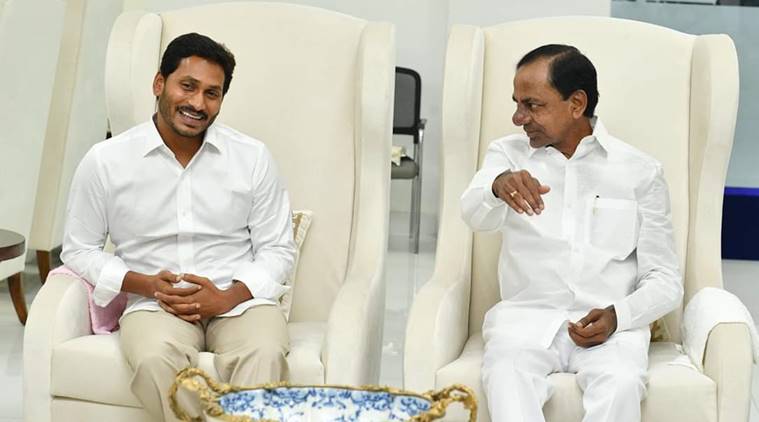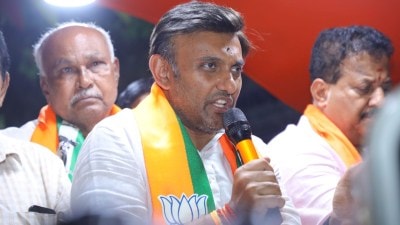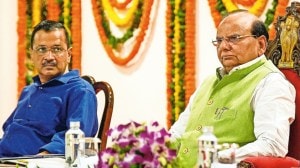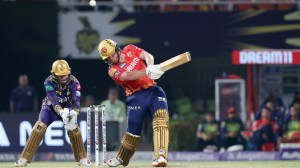- India
- International
Explained: Andhra Pradesh, Telangana — two states, two election stories
The results of the Lok Sabha elections in Andhra Pradesh and Telangana have shown both the strengths and weaknesses of regional parties. The elections have also demonstrated that the BJP can continue to expect to expand wherever the Congress remains the main opposition party
 Andhra Pradesh Chief Minister Y S Jagan Mohan Reddy and Telangana Chief Minister KCR (Twitter/YSRCP)
Andhra Pradesh Chief Minister Y S Jagan Mohan Reddy and Telangana Chief Minister KCR (Twitter/YSRCP)
Also written by Surya Rao Sangem & Gowd Kiran Kumar
The consolidation of the BJP’s 2014 performance has been the result of its ability to retain its position in the Hindi belt and to expand into new areas in the east and the south of the country. In the states of Andhra Pradesh and Telangana, regional parties have resisted the BJP’s mobilisation efforts to varying degrees.
In Andhra Pradesh, where the state election took place alongside the Lok Sabha election, the YSRCP improved upon its 2014 performance by bagging 22 seats and 49.2% of the vote. That left only three seats for the TDP — despite an over 39% vote share — and none for the Congress and the BJP, who got 1.3% and less than 1% of the vote respectively.
Jagan’s caste calculus
The YSRCP’s strategy bore a striking resemblance to the BJP’s: the projection, exclusively, of the party’s leader, Y S Jaganmohan Reddy, a formidable ground campaign backed by ample resources, a strong social media presence, and a caste-based strategy that combined favouring a local dominant caste while providing token representation to a large number of groups who were not affiliated with other parties.
The YSRCP distributed a quarter of its tickets to Reddy candidates, and an equal number of tickets (one) to eight different OBC groups — Boya, Gavara, Kalinga, Kurba, Padmasali (weavers), Setti Balija, Turpu Kapu and Yadav. It also distributed most of its SC tickets to Malas, and gave one ticket to a Madiga candidate.

The TDP, by contrast, banked mostly on Reddy and Kamma candidates, as well as on Rajus (OBC). Other forward or backward groups were hardly represented. This enabled the YSRCP to articulate a discourse of inclusion that played in its favour. It would seem that the YSRCP succeeded in consolidating support among Reddys as well as among varied OBC groups, many of whom used to support the TDP against the Congress earlier.
Jagan Reddy also announced various schemes favourable to OBCs, notably a Rs 15,000 crore BC subplan, and the “YSR cheyuta”, a monetary grant of Rs 45,000 for BC women.
Organisation, campaign
But the success of Yeduguri Sandinti Jaganmohan Reddy, known as Jagan Anna in Andhra Pradesh politics, can’t be explained only by savvy caste arithmetic. Within five years, he has succeeded in building an alternative to both the Congress and TDP from the ashes of the Congress state unit. While he did succeed in capturing the legacy of his father, Y S Rajasekhara Reddy, in terms of image, he did not inherit his organisation. He had to build it from the ground, through hard work and intense mobilisation, while facing various judicial challenges.
Read | How Prashant Kishor, Jagan Reddy outsmarted Naidu in Andhra
After his father’s death in September 2009, Jagan converted his Odarapu Yatra (condolence tour) into a direct political tool, after the Congress high command refused him the Chief Ministership. After his resignation from the Congress, he founded the Yuvajana Sramika Raithu Congress (Youth, Labour, and Farmers’ Congress), an acronym that evoked YSR’s name. He built from this episode a taste and talent for ground mobilisation. Ahead of the election, he led a 3,648-km padayatra, covering most constituencies over 341 days.
Jagan’s campaign was backed by Prashant Kishor’s I-PAC, which provided strategic support to several parties that were either BJP allies or were potential BJP partners. I-PAC designed an aggressive social media campaign, targeting students, farmers, and employees along with other groups loyal to YSRCP. It is no coincidence perhaps, that Jagan’s campaign resembled Modi’s.
 Naidu’s attention was divided between the state and the national stage, and many of his incumbent candidates suffered from a bad local reputation.
Naidu’s attention was divided between the state and the national stage, and many of his incumbent candidates suffered from a bad local reputation.
The campaign of Chandrababu Naidu, who was trounced in both the Lok Sabha and Vidhan Sabha elections, on the other hand, lacked the cohesiveness and sense of purpose displayed by his opponent. Naidu’s attention was divided between the state and the national stage, and many of his incumbent candidates suffered from a bad local reputation. He had backtracked on various promises made to OBC groups — notably the promise to grant a specific reservation status to Kapus.
Read | Election high over, YSR party now in a fix: How to fund campaign promises?
BJP in Telangana
The Telangana scenario was different — a three-corner fight between the Telangana Rashtra Samithi (TRS), the Congress, and the BJP which, unlike in Andhra Pradesh, led an aggressive grassroots campaign against both the other parties. Other parties like the TDP, the communists, the Jana Sena, and YSRCP were not in the race. AIMIM ran with an arrangement with the TRS.
Here, the disaffection for the Congress translated into votes for the BJP, which succeeded in wresting four seats: Adilabad, Karimnagar, Nizamabad, Secundrabad, all located in Northern Telangana. The BJP also finished second in Hyderabad and Mahbubnagar.
Few had anticipated this performance by the BJP, which can be explained by two main factors. First, a strong, cohesive booth-level campaign led by Manthri Srinivas, the BJP’s organising state secretary.
And second, the BJP fielded strong candidates at several seats.
* Soyam Babu Rao in Adilabad is a figure of the Gond tribal movement. He initially sought a Congress ticket, but joined the BJP ahead of the election.
* Bandi Sanjay Kumar (Karimnagar), who is considered an aggressive Hindutva face in Northern Telangana, had lost the Assembly election last December by a thin margin.
Read | Defeated in state polls, this time it’s different for these BJP, Cong candidates

* Dharmapuri Aravind (Nizamabad) is the son of D Srinivas, a former Congress minister who is currently a Rajya Sabha MP from the TRS. Aravind defeated Kalvakuntla Kavitha, daughter of TRS chief K Chandrashekar Rao (KCR), in what should have been a safe seat for the party. The fact that 179 farmers filed their nominations in Nizamabad, which topped the election in terms of number of candidates (185) did not help the TRS candidate either.
* G Kishan Reddy won the Secundrabad seat after having lost in the last state elections. He has also been growing rapidly within the party.
* In Mahbubnagar, the BJP fielded Aruna D K, a former TDP Minister who switched to the BJP before the election. She finished second.
Interestingly, the BJP won seats in subregions where ST and OBC votes matter the most. By gaining ground at the local level, the BJP has reiterated what it has done in many states since 2014: replace the Congress as the main opposition to a regional champion, by building ground-up organisation, and by poaching prominent faces from other parties.
The big picture
This result has come as a shock to the TRS, which had expected to sweep the state the way it did last December. Instead, it got ‘only’ eight seats, although with 41.3% vote share, significantly more than in 2014.
 AIMIM ran with an arrangement with the TRS.
AIMIM ran with an arrangement with the TRS.
Not only did the BJP succeed in making inroads, it also conquered TRS strongholds like Nizamabad and Karimnagar. Reports from the ground suggest that many Reddy voters did not support KCR, despite the fact that the TRS distributed a third of its tickets to that dominant group.
Two broad lessons can be drawn from the results in these two states.
The first is that regional parties cannot take their dominance for granted; the second is that the BJP can expect to expand wherever the Congress remains the main opposition party.
Gilles Verniers is Assistant Professor of political science, Ashoka University, and Co-Director of the Trivedi Centre for Political Data. Surya Rao Sangem is founder, MBC Times, and a Hyderabad-based political analyst. Gowd Kiran Kumar is a Research Scholar in the Department of Political Science at the University of Hyderabad. The caste data for both states was collected by Surya Rao Sangem and Gowd Kiran Kumar. Views are personal.
More Explained
EXPRESS OPINION
Apr 27: Latest News
- 01
- 02
- 03
- 04
- 05










































